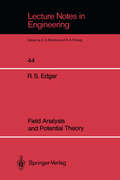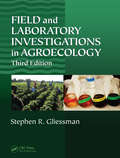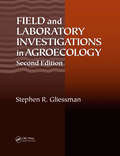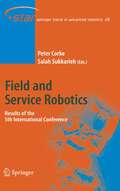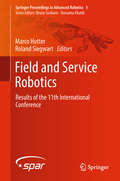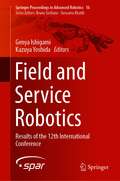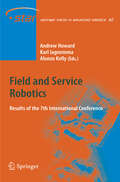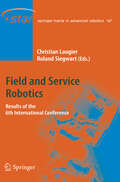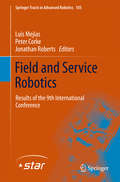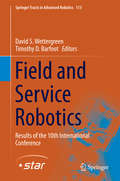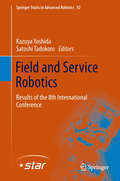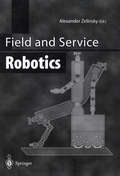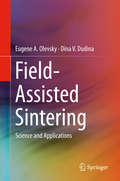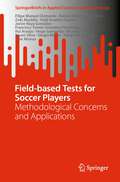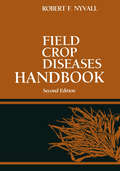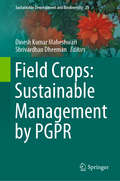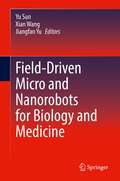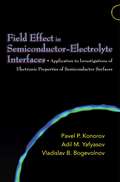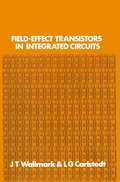- Table View
- List View
Field Analysis and Potential Theory (Lecture Notes in Engineering #44)
by Robert S. Edgar"Electromagnetic theory is a peculiar subject. The peculiarity resides not so much in the stratification - superposed layers of electrostatics. magnetostatics. steady currents and time-varying fields - as in the failure that has attended all attempts to weld these layers into a logical whole. The lowest layer. electrostatics. defines certain concepts. such as E. D, ~, in a way that is generally satisfactory only for the static case. Yet the attempt is made to force these specialised definitions into the higher strata, with ad hoc modifications when necessary. The student, in looking through his text books on electromagnetics, can find general definitions only with difficulty. if at all; and even the most advanced treatises fail to present a rigorously logical development of the subject". 1 So wrote Moon and Spencer some 30 years ago; and their criticism continues to be pertinent today. 2 More recently. a senior physicist of the National Bureau of Standards has expressed his concern in similar terms: "A logically consistent set of definitions of the electromagnetic field quantities is extremely difficult to find in the literature. Most text books either evade the problem or present definitions that are applicable only to special cases".
Field and Laboratory Investigations in Agroecology
by Stephen R. GliessmanAgroecology is defined as the application of ecological concepts and principles to the design and management of sustainable food systems. Hence, learning can best be achieved through an experiential approach to the topic. Designed to accompany Agroecology: The Ecology of Sustainable Food Systems, Third Edition, Field and Laboratory Investigations i
Field and Laboratory Investigations in Agroecology (PDF)
by Stephen R. GliessmanAgroecology is defined as the application of ecological concepts and principles to the design and management of sustainable food systems. Offering step-by-step guidance for structured investigation, Field and Laboratory Investigations in Agroecology, Second Edition reviews ecological concepts and principles in an agricultural setting.
Field and Service Robotics: Results of the 5th International Conference (Springer Tracts in Advanced Robotics #25)
by Peter Corke Salah SukkariehThe 5th International Conference on Field and Service Robotics (FSR05) was held in Port Douglas, Australia, on 29th - 31st July 2005, and brought together the worlds' leading experts in field and service automation. The goal of the conference was to report and encourage the latest research and practical results towards the use of field and service robotics in the community with particular focus on proven technology. The conference provided a forum for researchers, professionals and robot manufacturers to exchange up-to-date technical knowledge and experience. Field robots are robots which operate in outdoor, complex, and dynamic environments. Service robots are those that work closely with humans, with particular applications involving indoor and structured environments. There are a wide range of topics presented in this issue on field and service robots including: Agricultural and Forestry Robotics, Mining and Exploration Robots, Robots for Construction, Security & Defence Robots, Cleaning Robots, Autonomous Underwater Vehicles and Autonomous Flying Robots. This meeting was the fifth in the series and brings FSR back to Australia where it was first held. FSR has been held every 2 years, starting with Canberra 1997, followed by Pittsburgh 1999, Helsinki 2001 and Lake Yamanaka 2003.
Field and Service Robotics: Results of the 11th International Conference (Springer Proceedings in Advanced Robotics #5)
by Marco Hutter Roland SiegwartThis book contains the proceedings of the 11th FSR (Field and Service Robotics), which is the leading single-track conference on applications of robotics in challenging environments. This conference was held in Zurich, Switzerland from 12-15 September 2017. The book contains 45 full-length, peer-reviewed papers organized into a variety of topics: Control, Computer Vision, Inspection, Machine Learning, Mapping, Navigation and Planning, and Systems and Tools. The goal of the book and the conference is to report and encourage the development and experimental evaluation of field and service robots, and to generate a vibrant exchange and discussion in the community. Field robots are non-factory robots, typically mobile, that operate in complex and dynamic environments: on the ground (Earth or other planets), under the ground, underwater, in the air or in space. Service robots are those that work closely with humans to help them with their lives. The first FSR was held in Canberra, Australia, in 1997. Since that first meeting, FSR has been held roughly every two years, cycling through Asia, Americas, and Europe.
Field and Service Robotics: Results of the 12th International Conference (Springer Proceedings in Advanced Robotics #16)
by Genya Ishigami Kazuya YoshidaThis book comprises select proceedings of the 12th Conference on Field and Service Robotics (FSR 2019) focusing on cutting-edge research carried out in different applications of robotics, including agriculture, search and rescue, aerial marine, industrial, and space. It focuses on experiments and demonstrations of robotics applied to complex and dynamic environments and covers diverse applications. The essays are written by leading international experts, making it a valuable resource for researchers and practicing engineers alike.
Field and Service Robotics: Results of the 7th International Conference (Springer Tracts in Advanced Robotics #62)
by Alonzo Kelly Karl Iagnemma Andrew HowardRobotics is undergoing a major transformation in scope and dimension. From a largely dominant industrial focus, robotics is rapidly expanding into human en- ronments and vigorously engaged in its new challenges. Interacting with, assi- ing, serving, and exploring with humans, the emerging robots will increasingly touch people and their lives. Beyond its impact on physical robots, the body of knowledge robotics has p- duced is revealing a much wider range of applications reaching across diverse research areas and scientific disciplines, such as: biomechanics, haptics, neuros- ences, virtual simulation, animation, surgery, and sensor networks among others. In return, the challenges of the new emerging areas are proving an abundant source of stimulation and insights for the field of robotics. It is indeed at the int- section of disciplines that the most striking advances happen. The Springer Tracts in Advanced Robotics (STAR) is devoted to bringing to the research community the latest advances in the robotics field on the basis of their significance and quality. Through a wide and timely dissemination of critical - search developments in robotics, our objective with this series is to promote more exchanges and collaborations among the researchers in the community and c- tribute to further advancements in this rapidly growing field.
Field and Service Robotics: Results of the 6th International Conference (Springer Tracts in Advanced Robotics #42)
by Christian Laugier Roland SiegwartThis books presents the results of the 6th edition of "Field and Service Robotics" FSR03, held in Chamonix, France, July 2007. The conference provided a forum for researchers, professionals and robot manufacturers to exchange up-to-date technical knowledge and experience. This book offers a collection of a broad range of topics including: Underwater Robots and Systems, Autonomous Navigation for Unmanned Aerial Vehicles, Simultaneous Localization and Mapping, and Climbing Robotics.
Field and Service Robotics: Results of the 9th International Conference (Springer Tracts in Advanced Robotics #105)
by Luis Mejias Peter Corke Jonathan RobertsFSR, the International Conference on Field and Service Robotics, is a robotics Symposium which has established over the past ten years the latest research and practical results towards the use of field and service robotics in the community with particular focus on proven technology. The first meeting was held in Canberra, Australia, in 1997. Since then the meeting has been held every two years in the pattern Asia, America, Europe.Field robots are non-factory robots, typically mobile, that operate in complex and dynamic environments; on the ground (of earth or planets), under the ground, underwater, in the air or in space. Service robots are those that work closely with humans to help them with their lives. This book present the results of the ninth edition of Field and Service Robotics, FSR13, held in Brisbane, Australia on 9th-11th December 2013. The conference provided a forum for researchers, professionals and robot manufactures to exchange up-to-date technical knowledge and experience. This book offers a collection of a broad range of topics including: Underwater Robots and Systems, Unmanned Aerial Vehicles technologies and applications, Agriculture, Space, Search and Rescue and Domestic Robotics, Robotic Vision, Mapping and Recognition.
Field and Service Robotics: Results of the 10th International Conference (Springer Tracts in Advanced Robotics #113)
by David S. Wettergreen Timothy D. BarfootThis book contains the proceedings of the 10th FSR, (Field and Service Robotics) which is the leading single-track conference on applications of robotics in challenging environments. The 10th FSR was held in Toronto, Canada from 23-26 June 2015. The book contains 42 full-length, peer-reviewed papers organized into a variety of topics: Aquatic, Vision, Planetary, Aerial, Underground, and Systems. The goal of the book and the conference is to report and encourage the development and experimental evaluation of field and service robots, and to generate a vibrant exchange and discussion in the community. Field robots are non-factory robots, typically mobile, that operate in complex and dynamic environments: on the ground (Earth or other planets), under the ground, underwater, in the air or in space. Service robots are those that work closely with humans to help them with their lives. The first FSR was held in Canberra, Australia, in 1997. Since that first meeting, FSR has been held roughly every two years, cycling through Asia, Americas, Europe.
Field and Service Robotics: Results of the 8th International Conference (Springer Tracts in Advanced Robotics #92)
by Kazuya Yoshida Satoshi TadokoroFSR, the International Conference on Field and Service Robotics, is the leading single track conference of robotics for field and service applications. This book presents the results of FSR2012, the eighth conference of Field and Service Robotics, which was originally planned for 2011 with the venue of Matsushima in Tohoku region of Japan. However, on March 11, 2011, a magnitude M9.0 earthquake occurred off the Pacific coast of Tohoku, and a large-scale disaster was caused by the Tsunami which resulted, therefore the conference was postponed by one year to July, 2012. In fact, this earthquake raised issues concerning the contribution of field and service robotics technology to emergency scenarios. A number of precious lessons were learned from operation of robots in the resulting, very real and challenging, disaster environments. Up-to-date study on disaster response, relief and recovery was then featured in the conference. This book offers 43 papers on a broad range of topics including: Disaster Response, Service/Entertainment Robots, Inspection/Maintenance Robots, Mobile Robot Navigation, Agricultural Robots, Robots for Excavation, Planetary Exploration, Large Area Mapping, SLAM for Outdoor Robots, and Elemental Technology for Mobile Robots.
Field and Service Robotics
by Alexander ZelinskyJoe Engelberger, the pioneer of the robotics industry, wrote in his 1989 book Robotics in Service that the inspiration to write his book came as a reaction to an industry-sponsored forecast study of robot applications, which predicted that in 1995 applications of robotics outside factories - the traditional domain of industrial robots - would amount to less than 1% of total sales. Engelberger believed that this forecast was very wrong, and instead predicted that the non-industrial class of robot applications would become the largest class. Engelbergers prediction has yet to come to pass. However, he did correctly foresee the growth in non-traditional applications of robots. Robots are now beginning to march from the factories and into field and service applications. This book presents a selection of papers from the first major international conference dedicated to field and service applications of robotics. This selection includes papers from the leading research laboratories in the world together with papers from companies that are building and selling new and innovative robotic technology. It describes interesting aspects of robots in the field ranging from mining, agriculture, construction, cargo handling, subsea operations, removal of landmines, to terrestrial exploration. It also covers a diverse range of service applications, such as cleaning, propagating plants and aiding the elderly and handicapped, and gives considerable attention to the technology required to realise robust, reliable and safe robots.
Field-Assisted Sintering: Science and Applications
by Eugene A. Olevsky Dina V. DudinaThis book represents the first ever scientific monograph including an in-depth analysis of all major field-assisted sintering techniques. Until now, the electromagnetic field-assisted technologies of materials processing were lacking a systematic and generalized description in one fundamental publication; this work promotes the development of generalized concepts and of comparative analyses in this emerging area of materials fabrication. This book describes modern technologies for the powder processing-based fabrication of advanced materials. New approaches for the development of well-tailored and stable structures are thoroughly discussed. Since the potential of traditional thermo-mechanical methods of material treatment is limited due to inadequate control during processing, the book addresses ways to more accurately control the resultant material's structure and properties by an assisting application of electro-magnetic fields. The book describes resistance sintering, high-voltage consolidation, sintering by low-voltage electric pulses (including spark plasma sintering), flash sintering, microwave sintering, induction heating sintering, magnetic pulse compaction and other field-assisted sintering techniques. Includes an in-depth analysis of all major field-assisted sintering techniques;Explains new techniques and approaches for material treatment;Provides detailed descriptions of spark plasma sintering, microwave sintering, high-voltage consolidation, magnetic pulse compaction, and various other approaches when field-assisted treatment is applied.
Field-based Tests for Soccer Players: Methodological Concerns and Applications (SpringerBriefs in Applied Sciences and Technology)
by Filipe Manuel Clemente Rafael Oliveira Rui Silva Zeki Akyildiz Halil Ibrahim Ceylan Javier Raya González Francisco Tomás Fernández Rui Araújo Hugo Sarmento Ricardo Lima Bruno Silva Sérgio Matos Yung-Sheng Chen José AfonsoThis book systematically summarizes the accuracy, precision, and repeatability levels of field-based tests applied in soccer. It considers such details as the effectiveness of tests for different age categories and sexes. In this book, the readers will be able to check all the field-based tests conceived for fitness assessment in soccer through a large systematic review made to the literature. In addition a brief characterization of each test and presentation of the concurrent validity and repeatability levels for each test will be provided. Finally, the book contains a general discussion of the implications of the tests for different methodological approaches to training. It will be use to sports scientists and practitioners.
Field Crop Diseases Handbook (PDF)
by Robert F. NyvallA text and reference for students and professionals, this volume discusses the causes, distribution, symptoms, and control of the diseases of many of the world's important field crops.
Field Crops: Sustainable Management by PGPR (Sustainable Development and Biodiversity #23)
by Dinesh Kumar Maheshwari Shrivardhan DheemanThis book discusses the most challenging task ahead of researchers from India and around the globe: providing disease-free field crops for the ever-growing world population. In Asia, despite being cultivated in massive volumes, major crops, including cereals, oil seed, tuber and non-tuber vegetables, and fruit, are not meeting the demands of the increasing population. This book showcases naturally occurring beneficial microbes in the form of plant growth promoting rhizobacteria, or PGPR, which make it possible to grow field crops without applying synthetic chemicals.Our understanding of PGPR has increased exponentially in recent decades. They play a multifarious role in developing sustainable systems of crop production and protection. The book focuses on the mechanistic behaviors of PGPRs, their use to develop sustainable cultivation techniques, and their application to enhance crop growth and productivity at the cutting edge of tech-oriented agriculture and to replace hazardous chemicals with microbial inoculants. The book is useful to agronomists, microbiologists, ecologists, plant pathologists, molecular biologists, environmentalists, policy makers, conservationists, and NGOs working on organically grown field crops.
Field-Driven Micro and Nanorobots for Biology and Medicine
by Yu Sun Xian Wang Jiangfan YuThis book describes the substantial progress recently made in the development of micro and nanorobotic systems, utilizing magnetic, optical, acoustic, electrical, and other actuation fields. It covers several areas of micro and nanorobotics including robotics, materials science, and biomedical engineering. Field-Driven Micro and Nanorobots for Biology and Medicine provides readers with fundamental physics at the micro and nano scales, state-of-the-art technical advances in field-driven micro and nanorobots, and applications in biological and biomedical disciplines.
Field Effect in Semiconductor-Electrolyte Interfaces: Application to Investigations of Electronic Properties of Semiconductor Surfaces
by Pavel P. Konorov Adil M. Yafyasov Vladislav B. BogevolnovThis book presents a state-of-the-art understanding of semiconductor-electrolyte interfaces. It provides a detailed study of semiconductor-electrolyte interfacial effects, focusing on the physical and electrochemical foundations that affect surface charge, capacitance, conductance, quantum effects, and other properties, both from the point of view of theoretical modeling and metrology. The wet-dry interface, where solid-state devices may be in contact with electrolyte solutions, is of growing interest and importance. This is because such interfaces will be a key part of hydrogen energy and solar cells, and of sensors that would have wide applications in medicine, genomics, environmental science, and bioterrorism prevention. The field effect presented here by Pavel Konorov, Adil Yafyasov, and Vladislav Bogevolnov is a new method, one that allows investigation of the physical properties of semiconductor and superconductor surfaces. Before the development of this method, it was impossible to test these surfaces at room temperature. The behavior of electrodes in electrolytes under such realistic conduction conditions has been a major problem for the technical realization of systems that perform measurements in wet environments. This book also describes some material properties that were unknown before the development of the field effect method. This book will be of great interest to students and engineers working in semiconductor surface physics, electrochemistry, and micro- and nanoelectronics.
Field Effect in Semiconductor-Electrolyte Interfaces: Application to Investigations of Electronic Properties of Semiconductor Surfaces
by Pavel P. Konorov Adil M. Yafyasov Vladislav B. BogevolnovThis book presents a state-of-the-art understanding of semiconductor-electrolyte interfaces. It provides a detailed study of semiconductor-electrolyte interfacial effects, focusing on the physical and electrochemical foundations that affect surface charge, capacitance, conductance, quantum effects, and other properties, both from the point of view of theoretical modeling and metrology. The wet-dry interface, where solid-state devices may be in contact with electrolyte solutions, is of growing interest and importance. This is because such interfaces will be a key part of hydrogen energy and solar cells, and of sensors that would have wide applications in medicine, genomics, environmental science, and bioterrorism prevention. The field effect presented here by Pavel Konorov, Adil Yafyasov, and Vladislav Bogevolnov is a new method, one that allows investigation of the physical properties of semiconductor and superconductor surfaces. Before the development of this method, it was impossible to test these surfaces at room temperature. The behavior of electrodes in electrolytes under such realistic conduction conditions has been a major problem for the technical realization of systems that perform measurements in wet environments. This book also describes some material properties that were unknown before the development of the field effect method. This book will be of great interest to students and engineers working in semiconductor surface physics, electrochemistry, and micro- and nanoelectronics.
Field-effect Self-mixing Terahertz Detectors (Springer Theses)
by Jiandong SunA comprehensive device model considering both spatial distributions of the terahertz field and the field-effect self-mixing factor has been constructed for the first time in the thesis. The author has found that it is the strongly localized terahertz field induced in a small fraction of the gated electron channel that plays an important role in the high responsivity. An AlGaN/GaN-based high-electron-mobility transistor with a 2-micron-sized gate and integrated dipole antennas has been developed and can offer a noise-equivalent power as low as 40 pW/Hz1/2 at 900 GHz. By further reducing the gate length down to 0.2 micron, a noise-equivalent power of 6 pW/Hz1/2 has been achieved. This thesis provides detailed experimental techniques and device simulation for revealing the self-mixing mechanism including a scanning probe technique for evaluating the effectiveness of terahertz antennas. As such, the thesis could be served as a valuable introduction towards further development of high-sensitivity field-effect terahertz detectors for practical applications.
Field Effect Transistors, A Comprehensive Overview: From Basic Concepts to Novel Technologies
by Pouya ValizadehThis book discusses modern-day Metal Oxide Semiconductor Field Effect Transistors (MOSFETs) and future trends of transistor devices. This book provides an overview of Field Effect Transistors (FETs) by discussing the basic principles of FETs and exploring the latest technological developments in the field. It covers and connects a wide spectrum of topics related to semiconductor device physics, physics of transistors, and advanced transistor concepts. This book contains six chapters. Chapter 1 discusses electronic materials and charge. Chapter 2 examines junctions, discusses contacts under thermal-equilibrium, metal-semiconductor contacts, and metal-insulator-semiconductor systems. Chapter 3 covers traditional planar Metal Oxide Semiconductor Field Effect Transistors (MOSFETs). Chapter 4 describes scaling-driving technological variations and novel dimensions of MOSFETs. Chapter 5 analyzes Heterojunction Field Effect Transistors (FETs) and also discusses the challenges and rewards of heteroepitaxy. Finally, Chapter 6 examines FETs at molecular scales. Links the discussion of contemporary transistor devices to physical processes Material has been class-tested in undergraduate and graduate courses on the design of integrated circuit components taught by the author Contains examples and end-of-chapter problems Field Effect Transistors, A Comprehensive Overview: From Basic Concepts to Novel Technologies is a reference for senior undergraduate / graduate students and professional engineers needing insight into physics of operation of modern FETs.Pouya Valizadeh is Associate Professor in the Department of Electrical and Computer Engineering at Concordia University in Quebec, Canada. He received B.S. and M.S. degrees with honors from the University of Tehran and Ph.D. degree from The University of Michigan (Ann Arbor) all in Electrical Engineering in 1997, 1999, and 2005, respectively. Over the past decade, Dr. Valizadeh has taught numerous sections of five different courses covering topics such as semiconductor process technology, semiconductor materials and their properties, advanced solid state devices, transistor design for modern CMOS technology, and high speed transistors.
Field Effect Transistors, A Comprehensive Overview: From Basic Concepts to Novel Technologies
by Pouya ValizadehThis book discusses modern-day Metal Oxide Semiconductor Field Effect Transistors (MOSFETs) and future trends of transistor devices. This book provides an overview of Field Effect Transistors (FETs) by discussing the basic principles of FETs and exploring the latest technological developments in the field. It covers and connects a wide spectrum of topics related to semiconductor device physics, physics of transistors, and advanced transistor concepts. This book contains six chapters. Chapter 1 discusses electronic materials and charge. Chapter 2 examines junctions, discusses contacts under thermal-equilibrium, metal-semiconductor contacts, and metal-insulator-semiconductor systems. Chapter 3 covers traditional planar Metal Oxide Semiconductor Field Effect Transistors (MOSFETs). Chapter 4 describes scaling-driving technological variations and novel dimensions of MOSFETs. Chapter 5 analyzes Heterojunction Field Effect Transistors (FETs) and also discusses the challenges and rewards of heteroepitaxy. Finally, Chapter 6 examines FETs at molecular scales. Links the discussion of contemporary transistor devices to physical processes Material has been class-tested in undergraduate and graduate courses on the design of integrated circuit components taught by the author Contains examples and end-of-chapter problems Field Effect Transistors, A Comprehensive Overview: From Basic Concepts to Novel Technologies is a reference for senior undergraduate / graduate students and professional engineers needing insight into physics of operation of modern FETs.Pouya Valizadeh is Associate Professor in the Department of Electrical and Computer Engineering at Concordia University in Quebec, Canada. He received B.S. and M.S. degrees with honors from the University of Tehran and Ph.D. degree from The University of Michigan (Ann Arbor) all in Electrical Engineering in 1997, 1999, and 2005, respectively. Over the past decade, Dr. Valizadeh has taught numerous sections of five different courses covering topics such as semiconductor process technology, semiconductor materials and their properties, advanced solid state devices, transistor design for modern CMOS technology, and high speed transistors.
Field-Effect Transistors in Integrated Circuits (PDF)
by J. T. Wallmark L. G. CarlstedtField-Effect Transistors in Integrated Circuits
Field Emission Electronics (Springer Series in Advanced Microelectronics #60)
by Nikolay Egorov Evgeny SheshinThis book is dedicated to field emission electronics, a promising field at the interface between “classic” vacuum electronics and nanotechnology. In addition to theoretical models, it includes detailed descriptions of experimental and research techniques and production technologies for different types of field emitters based on various construction principles. It particularly focuses on research into and production of field cathodes and electron guns using recently developed nanomaterials and carbon nanotubes. Further, it discusses the applications of field emission cathodes in new technologies such as light sources, flat screens, microwave and X-ray devices.
Field Emission in Vacuum Microelectronics (Microdevices)
by George N. FurseyField emission is a phenomenon described by quantum mechanics. Its emission capability is millions times higher than that of any other known types of electron emission. Nowadays this phenomenon is experiencing a new life due to wonderful applications in the atomic resolution microscopy, in electronic holography, and in the vacuum micro- and nanoelectronics in general. The main field emission properties, and some most remarkable experimental facts and applications, are described in this book.
